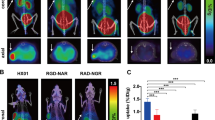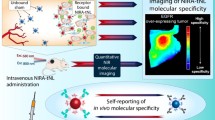Abstract
Purpose
Cellular receptor targeted imaging agents present the potential to target extracellular molecular expression in cancerous lesions; however, the image contrast in vivo does not reflect the magnitude of overexpression expected from in vitro data. Here, the in vivo delivery and binding kinetics of epidermal growth factor receptor (EGFR) was determined for normal pancreas and AsPC-1 orthotopic pancreatic tumors known to overexpress EGFR.
Procedures
EGFR in orthotopic xenograft AsPC-1 tumors was targeted with epidermal growth factor (EGF) conjugated with IRDye800CW. The transfer rate constants (ke,K12, k21, k23, and k32) associated with a three-compartment model describing the vascular delivery, leakage rate and binding of targeted agents were determined experimentally. The plasma excretion rate, ke, was determined from extracted blood plasma samples. K12, k21, and k32 were determined from ex vivo tissue washing studies at time points ≥24 h. The measured in vivo uptake of IRDye800CW-EGF and a non-targeted tracer dye, IRDye700DX-carboxylate, injected simultaneously was used to determined k23.
Results
The vascular exchange of IRDye800CW-EGF in the orthotopic tumor (K12 and k21) was higher than in the AsPC-1 tumor as compared to normal pancreas, suggesting that more targeted agent can be taken up in tumor tissue. However, the cellular associated (binding) rate constant (k23) was slightly lower for AsPC-1 pancreatic tumor (4.1 × 10−4 s−1) than the normal pancreas (5.5 × 10−4 s−1), implying that less binding is occurring.
Conclusions
Higher vascular delivery but low cellular association in the AsPC-1 tumor compared to the normal pancreas may be indicative of low receptor density due to low cellular content. This attribute of the AsPC-1 tumor may indicate one contributing cause of the difficulty in treating pancreatic tumors with cellular targeted agents.




Similar content being viewed by others
Change history
03 October 2023
A Correction to this paper has been published: https://doi.org/10.1007/s11307-023-01862-1
References
Adams GP, Weiner LM (2005) Monoclonal antibody therapy of cancer. Nat Biotechnol 23:1147–1157
Kovar JL, Simpson MA, Schutz-Geschwender A, Olive DM (2007) A systematic approach to the development of fluorescent contrast agents for optical imaging of mouse cancer models. Anal Biochem 367:1–12
Achilefu S, Dorshow RB, Bugaj JE, Rajagopalan R (2000) Novel receptor-targeted fluorescent contrast agents for in vivo tumor imaging. Invest Radiol 35:479–485
Becker A, Hessenius C, Licha K et al (2001) Receptor-targeted optical imaging of tumors with near-infrared fluorescent ligands. Nat Biotechnol 19:327–331
Durkin AJ, Bloomston PM, Rosemurgy AS et al (2003) Defining the role of the epidermal growth factor receptor in pancreatic cancer grown in vitro. Am J Surg 186:431–436
Korc M, Chandrasekar B, Yamanaka Y, Friess H, Buchier M, Beger HG (1992) Overexpression of the epidermal growth factor receptor in human pancreatic cancer is associated with concomitant increases in the levels of epidermal growth factor and transforming growth factor alpha. J Clin Invest 90:1352–1360
Baker CH, Solorzano CC, Fidler IJ (2003) Blockade of vascular endothelial growth factor receptor and epidermal growth factor receptor signaling for therapy of metastatic human pancreatic cancer. Cancer Res 62:1996–2003
Bruns CJ, Solorzano CC, Harbison MT et al (2000) Blockade of the epidermal growth factor receptor signaling by a novel tyrosine kinase inhibitor leads to apoptosis of endothelial cells and therapy of human pancreatic carcinoma. Cancer Res 60:2926–2935
Moore MJ, Goldstein D, Hamm J et al (2007) Erlotinib plus gemcitabine compared with gemcitabine alone in patients with advanced pancreatic cancer: a phase III trial of the National Cancer Institute of Canada clinical trials group. J Clin Oncol 25:1960–1966
Xiong HQ, Rosenberg A, LoBuglio A et al (2004) Cetuximab, a monoclonal antibody targeting the epidermal growth factor receptor, in combination with gemcitabine for advanced pancreatic cancer: a multicenter phase II trial. J Clin Oncol 22:2610–2616
Graeven U, Kremer B, Sudhoff T et al (2006) Phase I study of the humanised anti-EGFR monoclonal antibody matuzumab (EMD 72000) combined with gemcitabine in advanced pancreatic cancer. Br J Cancer 94:1293–1299
Samkoe KS, Hextrum SK, Pardesi O, O'Hara JA, Hasan T, Pogue BW (2010) Specific binding of molecularly targeted agents to pancreas tumors and impact on observed optical contrast. Proc SPIE 7568:75680H
Bartlett DW, Su H, Hildebrandt IJ, Weber WA, Davis ME (2007) Impact of tumor-specific targeting on the biodistribution and efficacy of siRNA nanoparticles measured by multimodality in vivo imaging. Proc Natl Acad Sci 104:15549–15554
Pogue BW, Samkoe KS, Hextrum S et al (2010) Imaging targeted-agent binding in vivo with two probes. J Biomed Opt 15:030513
Innis RB, Cunningham VJ, Delforge J et al (2007) Consensus nomenclature for in vivo imaging of reversibly binding radioligands. J Cereb Blood Flow Metab 27:1533–1539
Samkoe KS, Chen A, Rizvi I et al (2010) Imaging tumor variation in response to photodynamic therapy in pancreatic cancer xenograft models. Int J Radiat Oncol Biol Phys 76:251–259
Samkoe KS, Sexton K, Tichauer K et al (2011) Determination of blood plasma fluorescence extinction coefficients for dyes used in three-compartment binding model. Proc SPIE 7886:78860A
Segaert S, Van Cutsem E (2005) Clinical signs, pathophysiology and management of skin toxicity during therapy with epidermal growth factor receptor inhibitors. Ann Oncol 16:1425–1433
Velikyan I, Sundberg ÖL, Lindhe Ñ et al (2005) Preparation and evaluation of 68 Ga-DOTA-hEGF for visualization of EGFR expression in malignant tumors. J Nucl Med 46:1881–1888
Adams KE, Ke S, Kwon S et al (2007) Comparison of visible and near-infrared wavelength-excitable fluorescent dyes for molecular imaging of cancer. J Biomed Opt 12
Laruelle M, Baldwin RM, Rattner Z et al (1994) SPECT quantification of I-123 Iomazenil binding to benzodiazepine receptors in nonhuman-primates: 1. Kinetic modeling of single bolus experiments. J Cereb Blood Flow Metab 14:439–452
Tofts PS, Kermode AG (1991) Measurement of the blood–brain-barrier permeability and leakage space using dynamic MR imaging: 1. Fundamental-concepts. Magn Reson Med 17:357–367
Smith JJ, Derynck R, Korc M (1987) Production of transforming growth factor alpha in human pancreatic cancer cells: evidence for a superagonist autocrine cycle. Proc Natl Acad Sci 84:7567–7570
Kovar JL, Johnson MA, Volcheck WM, Chen J, Simpson MA (2006) Hyaluronidase expression induces prostate tumor metastasis in an orthotopic mouse model. Am J Pathol 169:1415–1426
Zhou M, Felder S, Rubinstein M et al (1993) Real-time measurements of kinetics of EGF binding to soluble EGF receptor monomers and dimers support the dimerization model for receptor activation. Biochemistry 32:8193–8198
Robertson MW, Leslie CA, Bennett JP (1991) Apparent synaptic dopamine deficiency induced by withdrawal from chronic cocaine treatment. Brain Res 538:337–339
Kallinowski F, Schlenger KH, Runkel S et al (1989) Blood-flow, metabolism, cellular microenvironment, and growth-rate of human-tumor xenografts. Cancer Res 49:3759–3764
Herholz K, Rudolf J, Heiss W-D (1992) FDG transport and phosphorylation in human gliomas measured with dynamic PET. J Neuro-Oncol 12:159–165
Okazumi S, Isono K, Enomoto K et al (1992) Evaluation of liver tumors using fluorine- 18-fluorodeoxyglucose PET: characterization of tumor and assessment of effect of treatment. J Nucl Med 33:333–339
Korc M (2007) Pancreatic cancer-associated stroma production. Am J Surg 194:S84–S86
Acknowledgements
This work was funded by NIH grants P01CA84201, R01CA109558, and R01CA156177.
Conflict of interest
The authors have no conflict of interest to disclose.
Author information
Authors and Affiliations
Corresponding authors
Rights and permissions
About this article
Cite this article
Samkoe, K.S., Sexton, K., Tichauer, K.M. et al. High Vascular Delivery of EGF, but Low Receptor Binding Rate Is Observed in AsPC-1 Tumors as Compared to Normal Pancreas. Mol Imaging Biol 14, 472–479 (2012). https://doi.org/10.1007/s11307-011-0503-5
Published:
Issue Date:
DOI: https://doi.org/10.1007/s11307-011-0503-5




